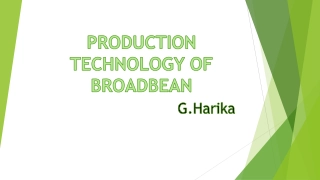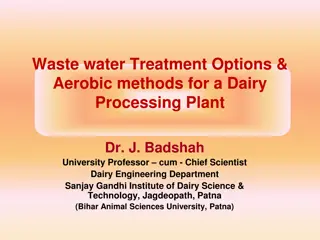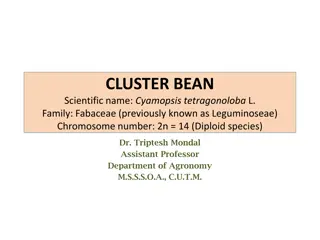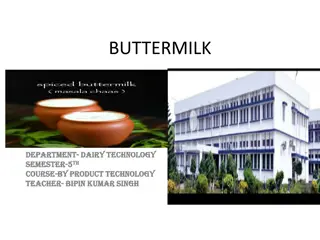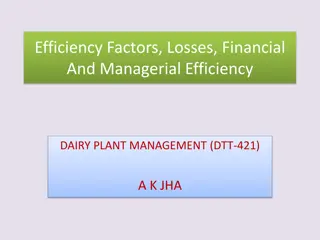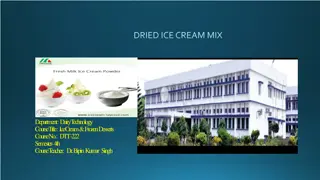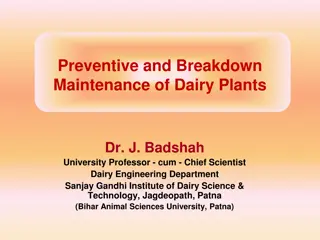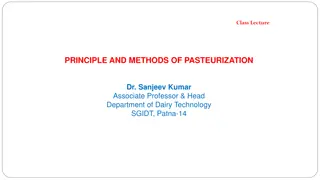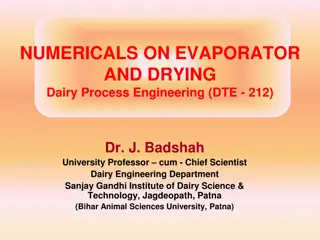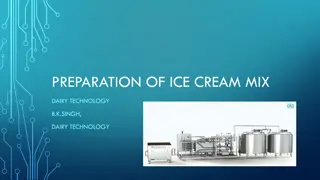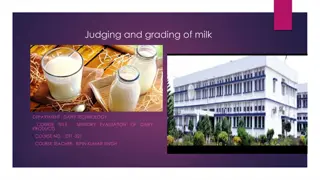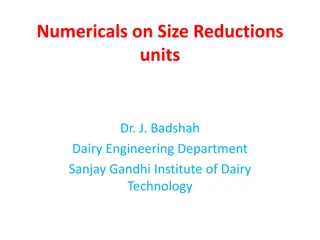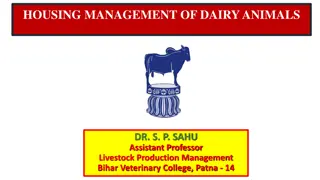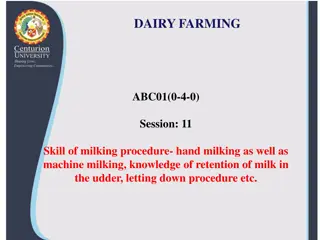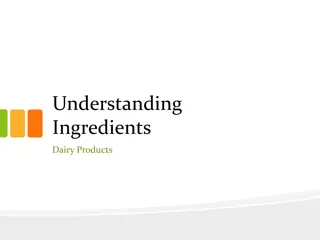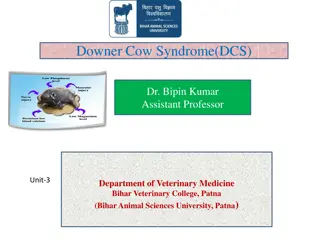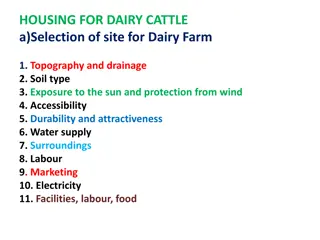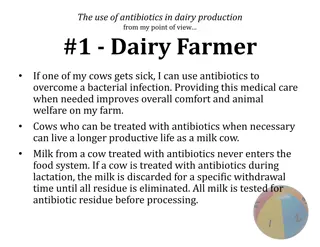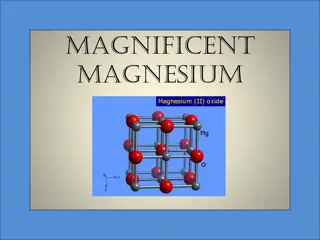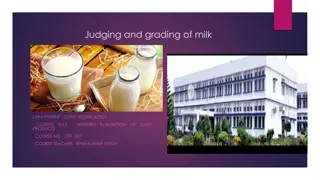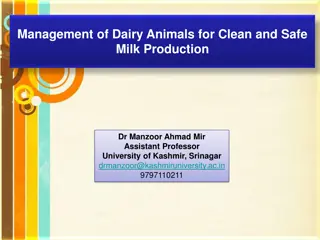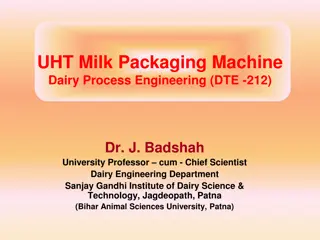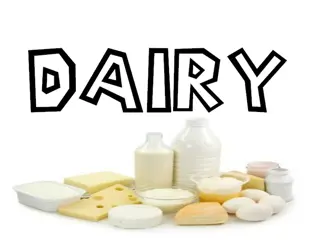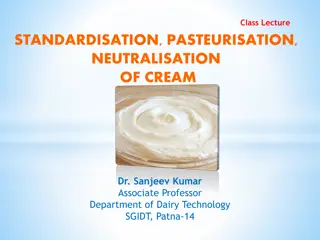Processing and Roasting of Cocoa Beans in Dairy Technology
This course in Food Technology explores the processing and roasting of cocoa beans in the Dairy Technology department. The objectives of roasting include moisture reduction, bean shell removal, chocolate flavor development, and color enhancement. Various roasting methods such as batch and continuous roasters, hot air treatment, and steam treatment are discussed. The flavor generation process involves Maillard browning and the production of aldehydes. Different roasting methods for beans and nibs are outlined, along with advantages and disadvantages. The importance of grinding cocoa nibs to achieve desired fineness for chocolate production is also highlighted.
Download Presentation

Please find below an Image/Link to download the presentation.
The content on the website is provided AS IS for your information and personal use only. It may not be sold, licensed, or shared on other websites without obtaining consent from the author. Download presentation by click this link. If you encounter any issues during the download, it is possible that the publisher has removed the file from their server.
E N D
Presentation Transcript
COCOA POWDER Department : Dairy T echnology Course Title : Food T echnology I Course No. : DTT -322 Course T eacher: Bipin Kumar Singh
Processing of Cocoa Bean Roasting Objectives of Roasting Reduction of moisture Release of the beans from the shell Develop chocolate flavour Changes the colour of the beans (nibs) affecting the appearance of the finished chocolate.
Roasters Batch or Continuous roasters Hot air treatment Saturated steam treatment Infra-red treatment Depending on the bean type, the beans are heated to 110-220oC. Temperatures from 70-200oC are reported depending on machine, and also on theusethatwillbemadeofthebeans. Certain type of milk chocolate requires beans with a very mild roasting. Whenpressingprocessis involved,a high roastisusedto: (i)obtainsufficientreduction in bacteriacount, and (ii)goodreductionin thermo-resistantspores.
Contd Flavour generation: Maillard browning forms glucosylamines or fructosylamines Other compounds formed include pyrazines, pyrroles, pyridines,imidazoles, thiazoles andoxazoles. Production of aldehydes from amino acids plays an important role in flavour balance of final chocolate; generation of carbonyls also takes place.
Roasting methods Bean roasting: Advantage Loosens the shell making it easier to remove. b) Disadvantages i. Shells from raw cocoa beans contain in dry state about 2% fat vs. 5-6% in roasted beans. ii. Combustion gases produced foreign materials on shell which is detrimental to flavour of cocoa mass. iii. Energy is lost when the shell is removed ii) Nib roasting: Advantage i. Particles roasted are of more uniform size. ii. Poorer cocoas can be upgraded by use of reducing sugar solutions or other treatments during roasting
Contd b) Disadvantage It is necessary to remove the shell from unroasted beans. iii) Mass roasting: Advantages i. Uniformity of heat treatment is ensured. ii. Bacteria on shell gets inactivated; lower initial bacterial count; better microbiological status.
Grinding The cocoa nib consists of 55% cocoa butter and 45% solid material coming from plant cells; the latter is ground finely. When eating chocolate or drinking chocolate milk, no grittiness should be felt in the mouth. Grinding confersthefollowingadvantages: Facilitatespressingoperation. Improvestherheologicalpropertiesofchocolate. Severalgrindingstepsarefollowed; Desired fineness is 15-70 um. Pre-grinding is carried out with Disc mills, hammer mill, pin mill. Ultimate fineness is achieved with Triple stone mill, Verticalballmills(attrittors).
Types of cocoa mass Cocoa mass may be used for the production of: Chocolate or (b) For pressing i.e.production ofcocoa butter and cocoa powder. Cocoa powder is either alkalized or non-alkalized. Alkalized cocoa powder contains potassium carbonate, sodium carbonate, sodium hydroxide or magnesium, all of which neutralizes the naturally occurring acids and make the powder easier to dissolve in liquids. Cocoa powder may also contain added starch (i.e. corn starch) to keep it free from caking during storage. Unsweetened cocoa powder is used primarily in baking. Sweetened cocoa powder is often mixed with hot milk or waterto product hotchocolate or hot cocoa .
Quality criteria for cocoa mass PARAMETERS VALUE Fat 50-58 Moisture Max. 2.50 PH 5.2-6.0 Shell content , % max 1.75 Total bacteria Max. 10000/g Moulds Max. 50/g Yeasts Max. 50/g Enterobacteria/g Negative E.coli/g Negative Salmonella/25g Negative
Cocoa Powder Dry cocoa solids are the components of cocoa beans remaining after cocoa butter, the fat component, is extracted from chocolate liquor, roasted cocoa beans that have been ground into a liquid state.Cocoa butter is 50% to 57% of the weight of cocoa beans and gives chocolate its characteristic melting properties. Cocoa powder is the powderedformof the solids sold as an end product.
Cocoa Powder(Production) Alkalizing Pressing Blending Grinding Cooling Packaging Storage




